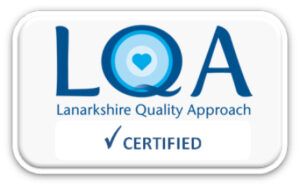Percutaneous Endoscopic Gastrostomy Guide (PEG)
Information for patients
NHS Lanarkshire Dietetic Department
PIL.PEREND.OO13.L
Gastrostomy Feeding
You are currently unable to take enough food and fluid by mouth to meet your nutritional needs or you may be unable to take any food or fluids by mouth at all.
Your gastrostomy feeding tube will enable you to meet your nutritional needs by feeding you directly into your stomach. A channel is then made into your stomach and this is referred to as the stoma.
Gastrostomy tubes are used for longer term feeding lasting more than four to six weeks.
PEG (Percutaneous Endoscopic Gastrostomy) tube
- A PEG tube can normally remain in place for at least two years if required.
- There is:
- an internal retention device, which holds the tube in your stomach.
- an external device, which holds the tube in the correct position on your skin.
- a feeding adaptor, which usually has a medicine port. This adaptor can be replaced when it becomes worn. Replacement adaptors are available to order through your Dietitian. It is helpful to ensure you always have a spare.
- These tubes are inserted in hospital using an endoscope, therefore it is not necessary to check that your tube is in your stomach unless there is concern that your tube may have moved. Please inform your health professional if you have any concerns.
- You should have been given a spare feeding tube, please take it with you if you have to attend hospital for a replacement. If you do not have a spare tube please let your health professional know.
Care of gastrostomy tube and stoma
Effective care of your tube and stoma are vital for your well-being. The aim is to prevent your tube blocking, maintain a healthy stoma site and to prevent infection and breakdown of the surrounding skin.
Wash hands thoroughly before and after handling the feeding system.
For the first 14 days:
- Leave the external fixation device in place.
- Check your stoma site daily for pain, swelling, redness or leakage.
- Clean your stoma site daily with cooled boiled water, paying particular attention to the skin – where possible leave exposed and dry thoroughly. Avoid using creams and talcum.
- After the first 24 hours of placement rotate the tube a full turn (360º) everyday.
- Shower instead of immersion bathing to allow the stoma tract to form.
Stop feeding and contact your Healthcare professional immediately if:
- There is pain on feeding
- External leakage of gastric contents
- Fresh bleeding
After 14 days:
- Clean your stoma with mild soap and water, rinse and dry thoroughly
- Loosening and rotating your gastrostomy tube a full turn (360º) daily, helps prevent the build-up of scar tissue and ensures that the internal retention device is not too tight.
- Flush your tube regularly with cooled boiled water before and after the administration of your feed or medication to help prevent tube blockage.
- Avoid using cream and talcum.
At all times:
- If you give medication down your tube it must preferably be in a liquid or dispersible form, please discuss this with your pharmacist. And remember to flush your tube before and after medication with 30 – 60 mls of cooled boiled water.
- If several medications are going down the tube, flush with at least 5 -10mls of cooled boiled water between each one.
If your tube does block, see troubleshooting guide.
Trouble Shooting Guide
| Problem | Possible Cause | Solution |
|
Tube will not flush. |
|
If all of the above are unsuccessful contact your feeding company nurse or health professional. |
|
GI problems e.g. nausea and vomiting Diahorrea. Constipation. |
|
|
|
Gastric Reflux |
|
|
|
If feeding tube comes out or dislodged. |
Contact your health professional to arrange for readmission to have tube re-inserted. |
Instructions on using your syringe
- The syringes you have been given can be reused for up to seven days.
- Clean your syringe straight after use
- Fill a bowl with hot soapy water
- Clean the end of the syringe by drawing the water in and out through the syringe until all traces of food or medicine are removed from the tip.
- Separate the two parts of the syringe and wash them.
- Then rinse them in water under the cold tap.
- Shake off the excess water and dry with a clean paper towel. Tapping the end of the syringe on a clean paper towel will dislodge any water that maybe still in the tip of the syringe.
- Store the syringe, still separated in a clean dry container.
- Put the syringe back together when you need to use it.
- You will usually be given one syringe for medicine and one for flushing cooled boiled water through your tube.
- If while you are using your syringe it becomes stiff or difficult to use, or if you can see any damage to the syringe or the markings become unclear you should throw it away and start to use a new one.
- If you use an extension set this can be reused for two weeks. Wash and store it in the same way as your syringes.
Pub. date: August 2020
Review date: August 2022
Issue No: 07
Reference: PIL.PEREND.OO13.L
20_07610
If you need this information in another language or format, please e-mail:





